Which Animal Is Most Commonly Found In Rock Art During The Bubalus Period?
Affiliate 3: Themes in African Fine art
Chapter 3.1 Animals
Why Animals Appear
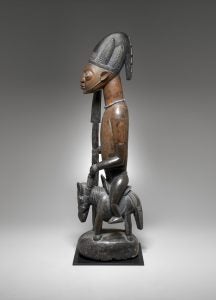
Animals often appear in traditional African art, but they are rarely chosen randomly as unproblematic representations of the natural world. They can serve equally accessories indicating status, such as the horse, who is an expensive creature that too elevates his passenger above others. Showing a figure atop a horse is a mutual indicator of a bully warrior, even when horses were rare in the area and thus unfamiliar to the artist. Even where horses were known, such as the Oyo Yoruba use of cavalry, the primacy of homo beings ways that the scale human relationship of man to equine is rarely natural–hieratic calibration usually ensures homo will dwarf animal (Fig. 145).
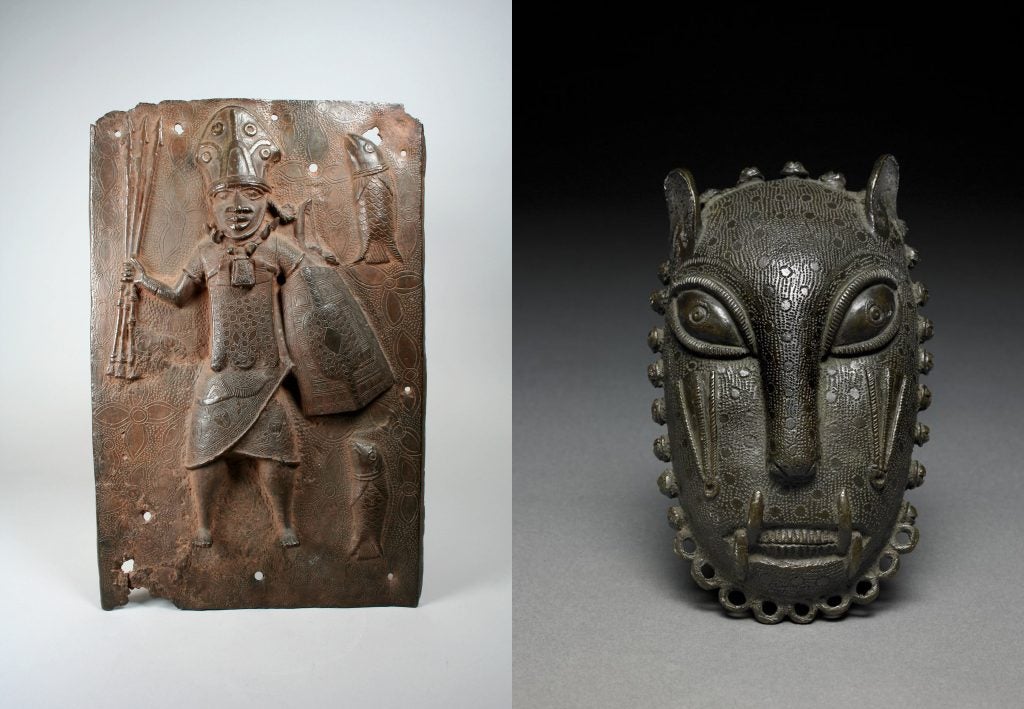
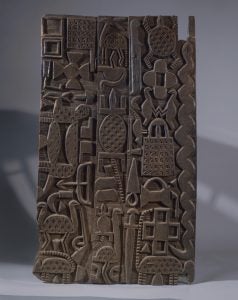
Powerful animals can serve as metaphors, such as the leopard and elephant who oftentimes symbolize monarchs or chiefs. These animals frequently serve as exact metaphors for powerful figures equally well. The Oba of Republic of benin Kingdom, for case, is referred to every bit the "leopard of the house," while his animal counterpart is the "leopard of the bush-league". Ane 15th-century Benin king's appellation was "the brave ambidextrous leopard who never misses his target." When this monarch is sleeping, his courtiers say, "The leopard is in his shelter"; if sick, "The leopard is ill in the wilderness." Why the leopard? Its beauty and deadliness echo those of the ruler. He was traditionally the only individual permitted to have like, though he might designate that right to certain courtiers, including his chiefs who were generals and their commanders. Soldiers wore tunics either made from leopardskin or from textile with embroidered leopard features, as well as brass hip pendants in the shape of a leopard's caput, confirming the Oba'south sanction to impale (Fig. 146).
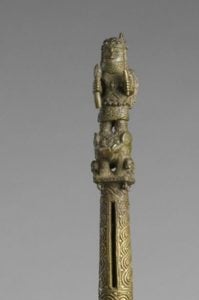
Elephants can symbolize the monarch in some parts of Africa, simply in the Republic of benin Kingdom they tend to represent powerful chiefs, sometimes those who attempt to rival the Oba. In the 18th century, the Iyase, the leader of the most aristocracy group of chiefs, rebelled and had a contentious relationship with two successive monarchs. When he was finally defeated, the victorious Oba had his artists create several works that showed him standing atop the elephant, emphasizing his triumph (Fig. 147).
Every bit we saw in Chapter Two, some animals represent praise names of specific rulers, as they did among the Fon of Dahomey Kingdom.
Liminal animals, previously discussed, often refer to persons of ability who straddle this human world and the spiritual world. Kings, priests, and witches have these abilities, which are often executed at night. Bats, birds, crocodiles, tortoises, mudfish, and pythons oftentimes appear in African art with such meanings.
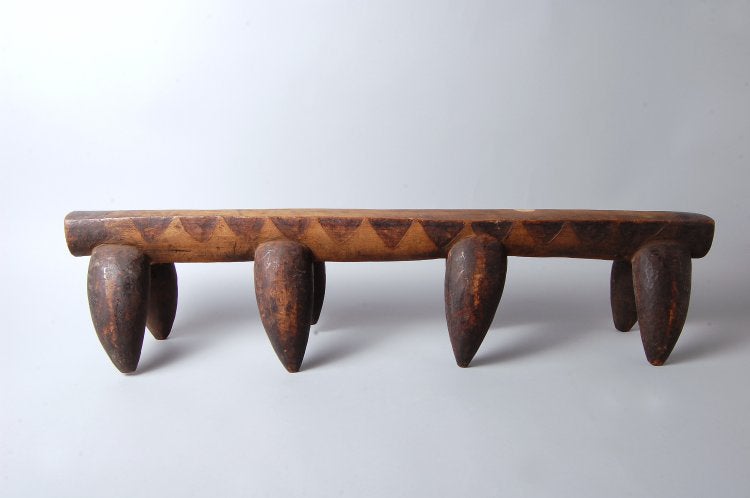
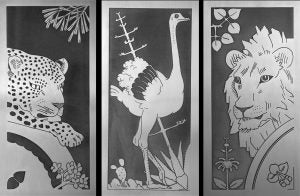
Sometimes a bird is just a bird, especially when it appears in a context with a mix of other animals, such as on a Nupe door (Fig. 148). Yet, even when animals reflect creatures from the natural globe, they may accept contextual layers of meaning. The Zulu, for example, attach high importance to cattle. In the past, cattle represented not only their everyday way of life as pastoral herders, they represented bridewealth, the number of cows a husband had to pay to his new married woman's family. Houses were organized in a band around the cattle enclosure, and ancestors were buried in the enclosure, with cattle sacrificed at their funerals. Zulu neckrests, used to support the head at night, often included references to cattle horns, since ancestral spirits often spoke to sleepers through dreams (Fig. 149).
In gimmicky art, animals may be featured every bit signifiers of Africa and its exotic elements. An early 20th-century corporate headquarters in Cape Town, South Africa, for example, included African animals on its exterior and interior, distinguishing markers that showed local affiliation rather than actress-continental buying (Fig. 150). Likewise, contemporary export fine art ofttimes includes images of antelopes, fish, snakes, and other animals as reminders of wilderness and nature.
Additional Readings
Abiodun, Rowland.Yoruba Art and Language: Seeking the African in African Art. New York: Cambridge Academy Press, 2014.
Anderson, Martha G. and Christine Mullen Kreamer.Wild Spirits, Stiff Medicine: African Fine art and the Wilderness. New York: Center for African Art, 1989.
Ben-Amos, Paula. "Men and animals in Republic of benin art." Mannorthward.s. 11 (2, 1976): 243-252.
Ben-Amos, Paula. "Majestic Fine art and Ideology in Eighteenth-Century Benin." Iowa Studies in African Art ane (1979): 67-86.
Blackmun, Barbara. "The face of the leopard: its significance in Benin court art."Allen Memorial Art Museum Message 44 (2, 1991): 24-35.
Nevadomsky, Joseph. "Signifying animals: the leopard and elephant in Benin art and culture." In Stefan Eisenhofer, ed.Kulte, Künstler, Könige in Afrika: Tradition und Moderne in Südnigeriae, pp. 97-108. Linz: Oberosterreichisches Landesmuseum, 1997.
Roberts, Allen F. Animals in African Art: From the Familiar to the Marvelous. New York: Museum for African Art, 1995.
Saharan Petroglyphs and Paintings
Some of Africa's oldest art forms feature animals, often clearly in move, dissimilar later on renditions. The exact significant of these renditions cannot e'er be unpacked, merely they conspicuously show peachy observations on the part of the artists involved, as well every bit considerable preliminary practice, possibly through drawing in the dirt first. While we tin't, perhaps, speak of "professional artists" from this catamenia, information technology seems
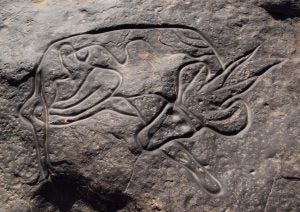
probable that specialist artists emerged, since certain works betray a sense of ease and confidence in line and form that are the result of consistent trials and refinement.
A huge area of the northern third of the continent is occupied by the Sahara desert, yet it has not e'er been barren land. While most of it was sand, apparently for millennia, well-nigh 12,000 years ago monsoons swept over the expanse repeatedly, irresolute information technology to savannah grasslands that supported giraffes, elephants, lions, hippos, rhinos, ostriches, and a large, now-extinct variety of wild buffalo (Bubalus antiquus).The Africans who lived in the area at present part of Niger, Great socialist people's libyan arab jamahiriya, Algeria, and Morocco commemorated these animals' presence through petroglyphs, or rock engravings, that they ground into rock outcrops with stone tools (Fig. 151). These petroglyphs are the only remaining art grade from the menstruum, which ranges from about 10,000-6000 BCE, when the climate shifted and became less moist, no longer able to back up these animals.

The smooth, fluid lines of many of these incised drawings belie the tedious nature of the task. The creation of each line would take been a fourth dimension-consuming procedure. Some images, such as the Dabous giraffe petroglyph (Fig. 152), are life-sized and include interior lines indicating the animal's markings. They were incised in sandstone, the aforementioned material used for the Mt. Rushmore presidential heads, the Great Sphinx, and many other world monuments. Sandstone'due south hardness is measured every bit 6-7 on the Mohs scale (a diamond is x), so creating these lines was no mean feat. Fifty-fifty the hairs on the spinal ridge are indicated.
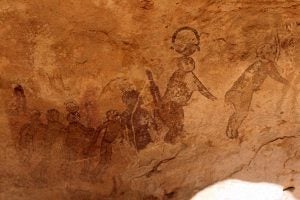
From virtually 8000-6000 BCE, petroglyph production overlapped with paintings made from natural pigments. The weather pattern had changed; whether the population did likewise, or whether their fine art forms merely took a different direction is unclear, just animals no longer were the centre of their depictions. Instead, in this and then-chosen Roundhead Period (Fig. 153), human forms began to dominate. Although their bodies are physically recognizable, they are less skillfully-wrought and naturalistic than the before petroglyph animals, and with far less variety in pose. Their heads are characterless and helmet-like, their bulky bodies sometimes showing dotted lines of body paintings. Particular works may show greater sophistication in depicting depth–overlapping and diminution equally distance increases–but tend to lack grace.
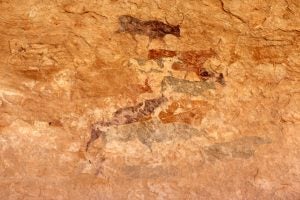
As the climate continued to shift, so also did the populations and their lifestyle. Reduction in the lush mural sent
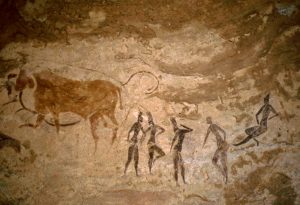
drove certain animals southward, and the emerging savannah grasslands became home to peoples who herded cattle, rather than following a hunter-gatherer lifestyle. They also produced paintings rather than petroglyphs, documenting non only their herds but themselves (Fig. 154). These skilled works besides seem to have been the work of specialists, and they gathered earthen pigments, combining them with milk and egg yolk to bind the paint onto rocky surfaces. This period is variously known equally the Pastoral, Bovine, or Bovidean Flow, dating from nearly 5500-2000 BCE.
Depictions of people in these images testify them in elegant silhouette course (Fig. 155), their heads and other extremities small in proportion. They are situated in breezy poses, conversing, relaxing, playing with their children, hunting, and herding. These paintings seem to be neither iconic images nor religious works, withal–similar the petroglyphs–we have no absolute knowledge of the motivations behind them. Both the makers of rock engravings and the paintings of the cattle herding menses announced to accept been nomadic, then they did non mark permanent settlements (although they may have been revisited). Nomadic peoples have periods of idle time betwixt hunts or while the cattle are grazing–did they create these for sheer pleasure? That remains unknown.
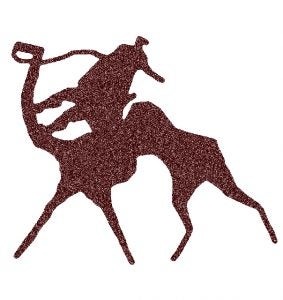
That the cattle are depicted on the paintings in specific ways–that is, their marking individualizes them in a portrait-like style–yet the people remain featureless silhouettes may indicate beliefs that recognizable human being images could potentially impairment the living. However, cattle are so important to herders that it seems unlikely that, with such a conventionalities in mind, the artists would betrayal cattle to a similar vulnerability through visual representation. Both people and animals are treated with sophisticated conceptual approaches. They are frequently shown in motion, and depth is suggested both through overlapping and positioning on the surface (i.e., things further away are placed towards the tiptop of the limerick).
When the climate continued to dry out out, the cattle and their owners also obviously moved southward. Paintings of people with horse-drawn chariots (m BCE-1 CE), followed by camels and riders (beginning ca. 200 BCE) followed (Fig. 156) as desertification intensified. While animals continued to be somewhat naturalistic, the incoming Berber populations mostly distorted images of people or constructed them geometrically.
Further Reading
Bradshaw Foundation. "The Globe'south Largest Rock Art Petrogylph: Giraffe Carvings of the Sahara Desert."
Hansen, Jörg W.Tassili: art rupestre dans les Tassilis de fifty'ouest et du sud algérien = stone art in the western and southern Tassilis, Algeria = Feldsbildkunst in den westlichen und südlichen algerischen Tassilis = arte rupestre nei Tassili dell'ovest e del sud algerino. Paris: Somogy éditions d'art, 2009.
Holl, Augustin F. C.Saharan rock art: archæology of Tassilian pastoralist iconography. Walnut Creek, CA: AltaMira Printing, 2004.
Soukopova, Jitka.Chronology, origins and evolution of the Circular Caput fine art. Newcastle, United kingdom of great britain and northern ireland: Cambridge Scholars, 2012.
South African Rock Paintings: Game Laissez passer Shelter
Due south Africa and its neighbors are also the site of numerous examples of rock art. These are primarily paintings, merely their dating range is more encompassing than those of the Sahara. Created by the San peoples, the region's original inhabitants, they were first made as early or earlier than some of the desert artworks and continued into the 19th century. Until recently, their dating was difficult–it involved flaking off large pigment sections for carbon-dating, which destroyed the works. In 2017, a variation of carbon dating was used. This method–accelerator mass spectrometry radiocarbon dating (AMS)–uses very pocket-size sample sizes. Tested at 14 sites, the oldest of these (in Botswana) yielded dates circa 3700-2400 BCE.
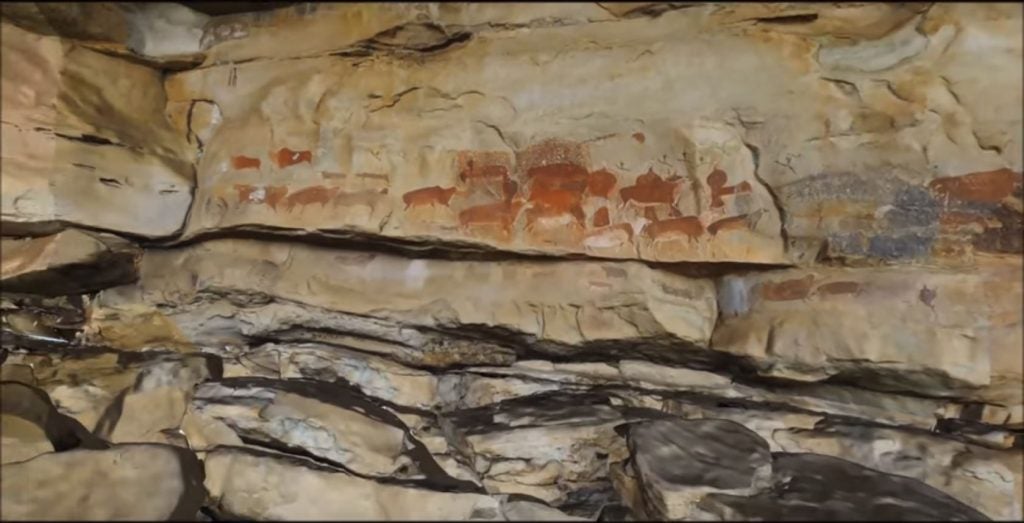
Most southern African rock paintings draw animals and/or peoples, and were interpreted for a long time equally descriptive, recording scenes the San artists–who were hunter-gatherers–were familiar with. Not all paintings, however, seemed to draw solely natural scenes. One particular set of paintings, located in the Game Pass Shelter of the Drakensberg mountains (Fig. 157)–a region with the highest concentration of rock art in southern Africa–provided clues that led to a new interpretation of the artworks there and elsewhere.
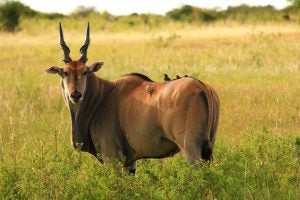
The San no longer alive in this area. White settlers pushed them further west in the 19th century, although they still inhabit Namibia, Botswana, and bordering areas of Due south Africa. When documented regional San religious traditions recorded in the 19th century were considered in respect to one of this rock outcrop's paintings (Fig. 157), a new hypothesis
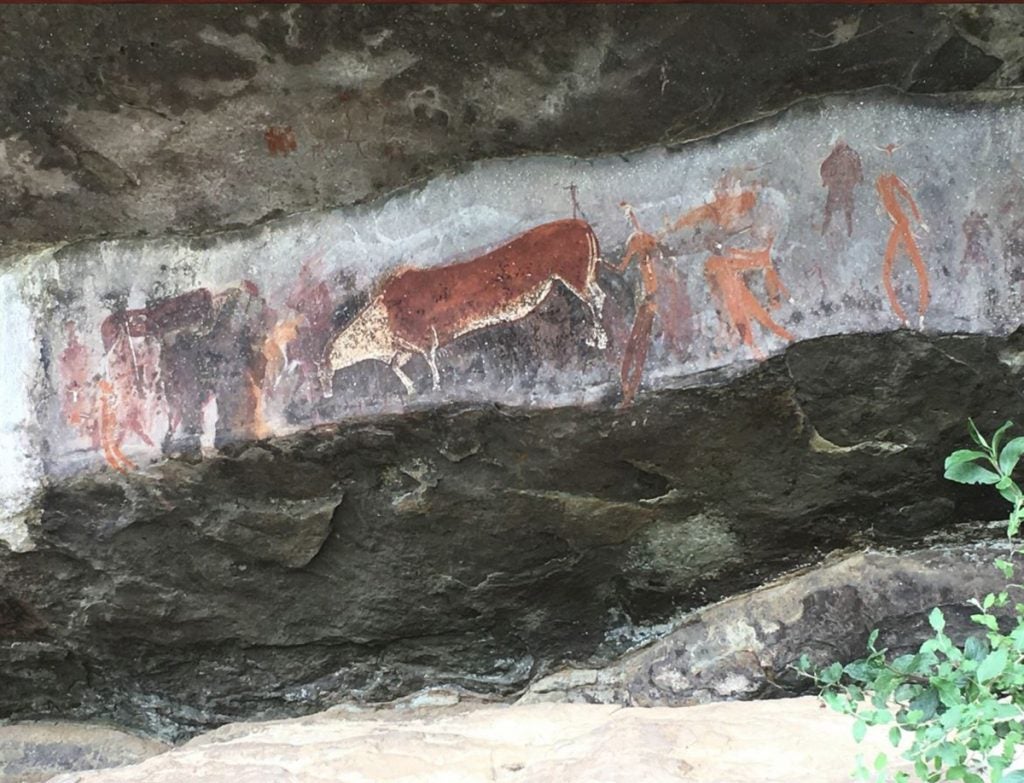
emerged, and this was strengthened by knowledge of the electric current healing practices of Western San ritual specialists. The latter are able to bring supernatural forces into play by either going into trance during group dances or dreaming in a trance state. Trances are induced by elements that focus on the notion of spiritual authority (due north/um)–this could exist certain songs, the cede of a particular animal, a particular place. The healer, when participating in a group trip the light fantastic toe, becomes more than and more attuned to the spiritual globe and begins to quiver, stagger, sweat, lower their head, and drain from the olfactory organ as they fall into a trance, a process referred to every bit "dying". In that state, they affect those with disorders and heal them, or may feel hallucinations that provide insight. Nineteenth-century accounts from the southern San written report ritual specialists similarly quivering when manifestly asleep, their powers exercising. Besides healers, ritual specialists might take expertise in controlling rain or game, or choose a malevolent path as a sorceror.
Asleep or awake, in trance they are believed to reach out-of-body experiences involving transformation into a variety of animal forms, some of which are considered more spiritually stiff than others. Although San artists painted many types of animals, the eland, the largest variety of antelope (Fig. 158), appears with greatest frequency. Artists painted eland in a surprising multifariousness of poses, including views from the hindquarters, and gave its anatomy more than attending than that of other animals, even including modeling through shading and highlights. It is associated with farthermost dominance, its fatty is used in numerous San rites.
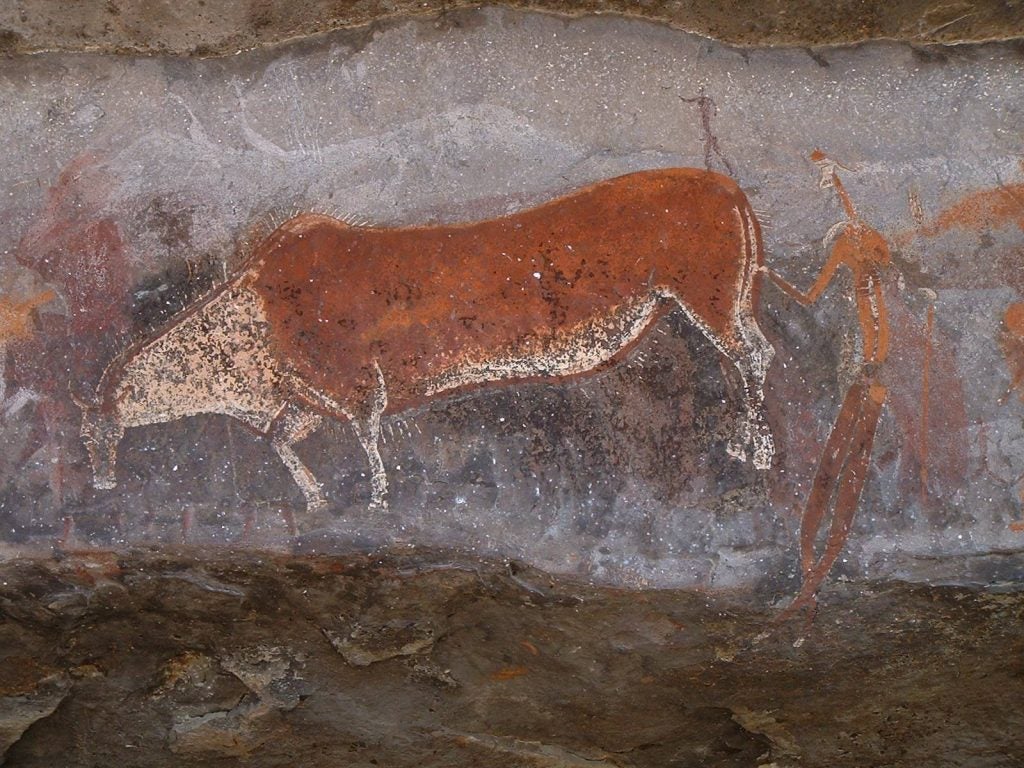
One of the Game Pass Shelter's painted passages–sometimes called the "Rosetta Rock" of San rock art because its interpretation helped decode paintings throughout southern Africa–concentrates on a dying eland with nearby humans (Fig. 158). The San use poisoned arrows to hunt eland; the poison acts on their organisation past making them lower their heads and plough them from side to side. They sweat, their bodies tremble, the hair along their spine erects, they stagger, and finally plummet in death. This depiction shows the death throes, white dots representing sweat, one front leg bent while the back legs cross in a stagger, the head lowered and turning, and spinal hairs standing straight upward. The figures behind the eland, however, demonstrate that this is no uncomplicated hunting scene.
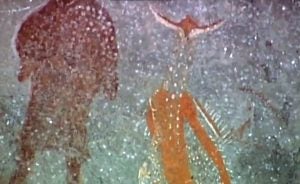
I elongated figure (Fig. 159) stands immediately behind the animate being, gripping its tail. Its head is antelope-similar, not human being, and white dots of sweat surround it. Tellingly, its legs are crossed in a staggering position, and white-tipped hooves replace its feet. The spiritual potency of the dying animal has been transferred to the ritual specialist, who is transforming into an eland in his trance state. Behind him are additional figures in various stages of transformation. One bends forward at the waist, another is covered with a tented skin garment (kaross), while a 3rd (Fig. 160) also bears an eland head, sheds sweat, has upright torso hair rendered identically to that of the eland, with both hands and feet transformed into hooves. They are therianthropes, metamorphosed shape-shifters who can cross the borders into the spiritual earth.
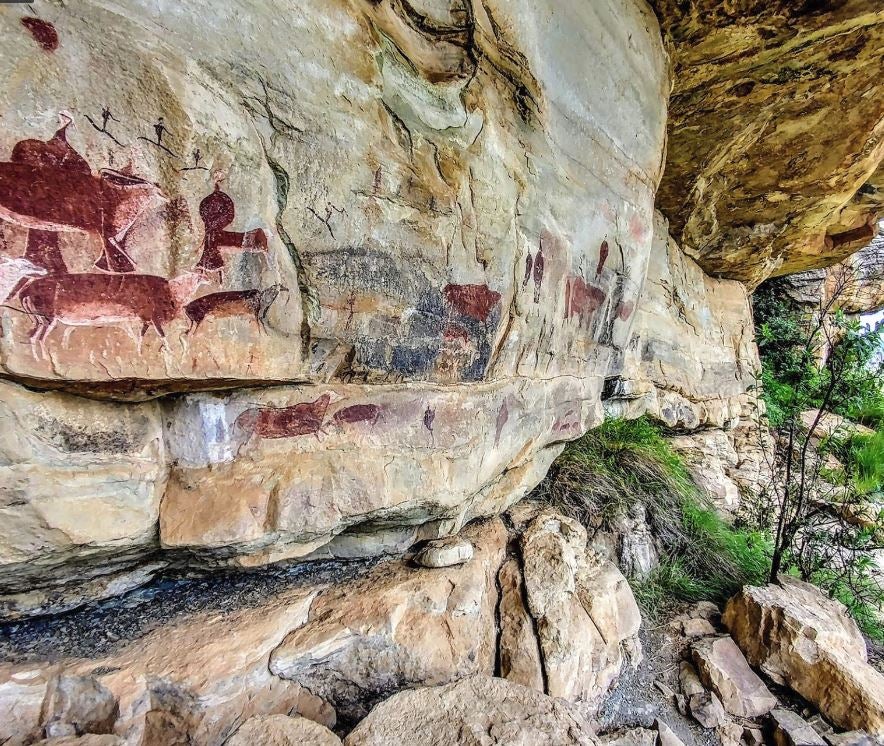
Other paintings in Game Laissez passer Shelter draw multiple elands accompanied by homo beings enveloped in pare garments (Fig. 161). These cloaks' shape mimics the hump of the antelopes, and their heads have already transformed to animal forms, their anxiety to hooves. Other locations may depict figures who are human and merely wearing skins with the head attached, or fifty-fifty masks (though the San are not known to have ever used wooden masks). The hooves of these figures preclude the notion of a disguise in this example, only at that place are other San paintings that suggest that even the act of kaross-wearing may accept been intended to facilitate trance and transformation.

Game Pass Shelter and the Drakensberg's other rock fine art have become a UNESCO Earth Heritage site when the entire uKhahlamba-Drakensberg Park was so declared in 2000. Although the San were said to no longer live in the area, both authorities agencies and UNESCO recognize the presence of a local clan that intermarried and alloyed among neighboring peoples in the 19th century in order to survive. Their self-recognition equally San–as well as their neighbors' awareness of their origins–connected. One man recalled coming to one of the Drakensberg caves in the 1920s, his initiator using painting as an instructional assist. Since 2002, a growing number of this "subconscious" clan'south members has been using the Game Pass Shelter site in an almanac attempt to communicate with their ancestors, limited in part because of site restrictions on burn down and the enforced presence of outsiders at a private rite.
Further Reading
The African Rock Art Digital Archive. http://www.sarada.co.za/#/library/
Bonneau, Adelphine, David Pearce, Peter Mitchell, Richard Staff, Charles Arthur, Lara Mallen, Fiona Brock, and Tom Higham. "The earliest straight dated rock paintings from southern Africa: new AMS radiocarbon dates."Antiquity 91 (April, 2017): 322–333.
Dowson, Thomas. "Debating Shamanism in Southern African Rock Art: Time to Motility On . . . " The South African Archaeological Bulletin62 (185, 2007): 49-61.
Jolly, Peter. "Therianthropes in San Stone Fine art."The South African Archaeological Bulletin 57 (176, 2002): 85-103.
Lewis-Williams, J. David. Believing and seeing: symbolic meanings in southern San rock fine art. London: Academic Press, 1981.
Lewis-Williams, J. David. "A Dream of Eland: An Unexplored Component of San Shamanism and Rock Fine art."World Archæology 19 (2, 1987): 165-177.
Lewis-Williams, J. David. "The Thin Reddish Line: Southern San Notions and Rock Paintings of Supernatural Potency." The South African Archaeological Bulletin 36 (133, 1981): 5-xiii.
Lewis-Williams, J. David, G. Blundell, West. Challis and J. Hampson. "Threads of Low-cal: Re-Examining a Motif in Southern African San Rock Art."The South African Archaeological Bulletin 55 (172, 2000): 123-136. 67.
Lewis-Williams, J. David and David One thousand. Pearce. "Framed Idiosyncrasy: Method and Evidence in the Interpretation of San Rock Art." The Southward African Archaeological Bulletin 67 (195, 2012): 75-87.
Ndlovu, Ndukuyakhe. "Admission to Rock Art Sites: A Correct or a Qualification?"The S African Archaeological Bulletin64 (189, 2009): 61-68.
Prins, F. E. "Hush-hush San of the Drakensberg and their rock fine art legacy." C ritical Arts 23 (2, 2009):190-208.
Smith, Benjamin. "Rock Art in South African Society Today." In L.Yard. Brady and P.S.C. Tacon, eds. 2016.Relating to Rock Art in the Gimmicky Earth: Navigating Symbolism, Meaning andSignificance, pp. 127-156. Boulder, CO: University Press of Colorado, 2016.
The Ciwara of Mali'due south Bamana People
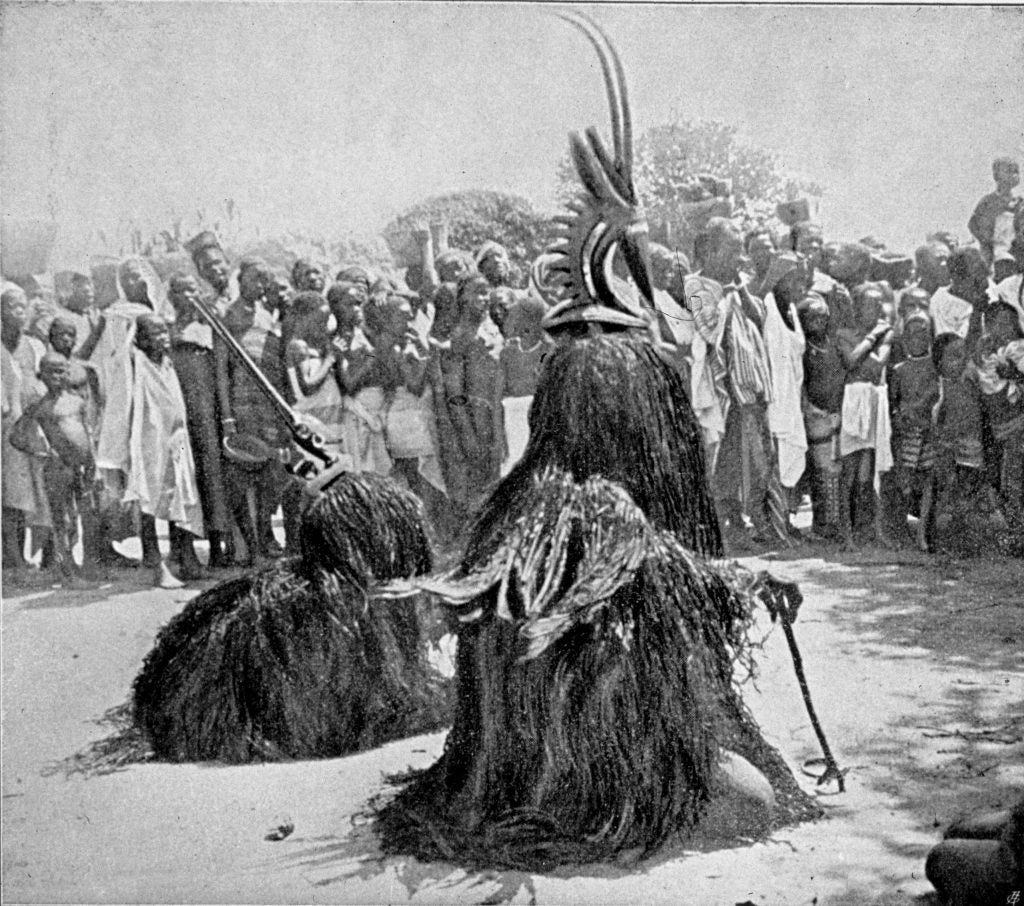
The Bamana people of Mali are one of the Mande-speaking peoples, many of whom were part of a succession of empires and kingdoms that persisted until the 19th century. Although the majority of Bamana are Muslim today, equally recently every bit the 1970s a substantial number of Bamana proficient traditional religion, even though Islam and lifestyle changes had already had a significant bear upon on culture. The Bamana and many of their rural neighbors live in a casted gild; that is, to a great extent birth determines occupation and marriage patterns. Farmers–landowners–constitute the nobility; other groups consist of artists/artisans (nyamakalaw, or "ability handlers"), while slaves in one case constituted a third societal category. Daily rural life used to exist organized around initiation societies with varied specialized purposes. One, the Ciwara Society, was organized effectually immature farmers and a spiritual connection to the state.
During the planting flavor, then and now (see video below), young men from their late teens to early 30s clear the fields in communal efforts, drummers and women'due south vocal spurring them on. Up until the early on 20th century, male masqueraders danced in the fields, usually in pairs representing a male/female person (often with a baby) antelope or in threes–their fertility and the fertility of the fields were linked. Antelope imagery alluded to the supernatural being Ci Wara, a half-man, half-creature spirit that generally adopted an antelope form. He taught agronomics to the Bamana during primordial times until, disappointed with mankind's behavior, he disappeared into the ground. The masquerade headpieces made in his memory–too chosen chi wara or tji wara–bear his proper name, which is also accorded to champion farmers to praise them every bit they work hard in the fields.
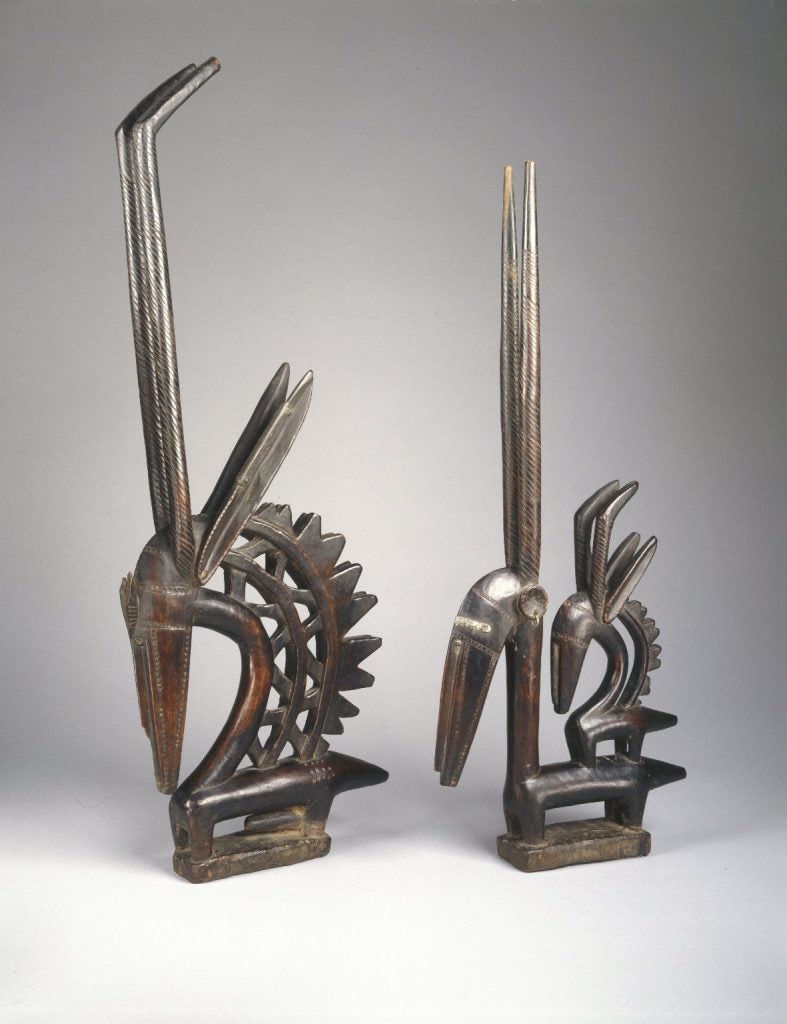
A community'due south Ciwara gild kept a shrine containing a boli ability object that acted as an altar for the spirit of Ci Wara, receiving periodic sacrifices. Masquerades took place before the rainy flavour, a time when fields were cleared in preparation for planting, besides as during the rains, and at harvest fourth dimension. Performers danced with their bodies bent forward, holding sticks that represented front legs. The beast carvings were not truthful masks–that is, they did not comprehend the face up. Instead, they were attached to basketry caps secured to the head, with a fiber costume made from wilderness materials covering both the upper trunk and face up of the masqueraders (Fig. 163); in the Mande Plateau area of southward-primal Mali, birds' feathers are added to the costume. When non in use, these masquerade crests were stored in the shrine nigh the boli, soaking up some of its spiritual power. A pocket-sized piece of the boli would be buried along the masqueraders' route and plow the first female person crossing it into the champion of the women; the male antelope masquerader would swallow her food. Another boli piece was attached to 1 of the male antelope dancer's sticks or in the basketry cap on his head, while the masquerader portraying Ci Wara'southward married woman had a piece of the boli in a leather bag at the back of his waist. These empowered the dancers and probably the community'due south farming likewise.
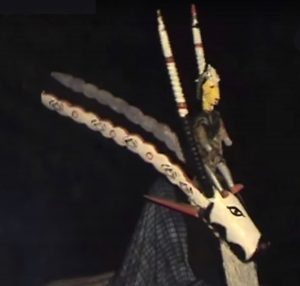
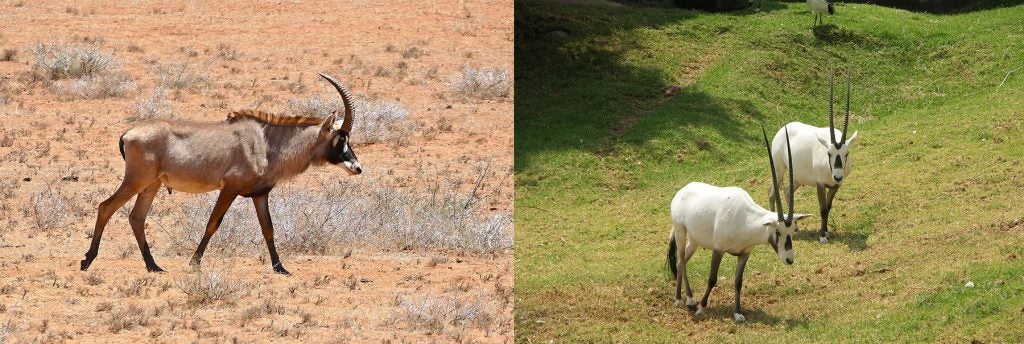
By the plow of the 20th century, some communities danced in the village foursquare rather than in the fields, and by the mid-20th century, growing Islamicization and Bamana migration to cities continued to impact the initiation gild. Some ritual performances were now solely entertainment, danced in front of the mosque on Muslim holidays. Every bit the initiation society transformed, other farming organizations–both paid and charitable–emerged. Some of these also commissioned antelope masks to perform in the fields just earlier the rainy season, while others danced in town. Many of these crests looked like the ciwara, since the same artists were responsible for making both. Those sculptors werenyamakalawblacksmiths, who are the carvers amidst the Baule, in addition to forging metal objects and acting as ritual specialists (run into Chapter 3.5). As the 20th century progressed, field performances of any kind macerated and fifty-fifty disappeared in most areas, although both ritual and entertainment ciwara persisted in the Mande Plateau region into the 1990s and may notwithstanding exist. Brightly-painted antelopes (Fig. 164) became standard subjects in secularcheko performances past youths that apply masquerades and puppets to entertain young women and the community every bit a whole. The clan of antelope with grace and farming continued, even as its spiritual and specific mythological associations faded.
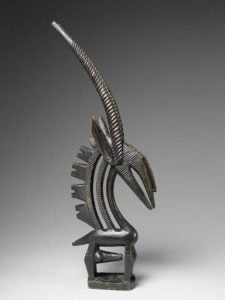
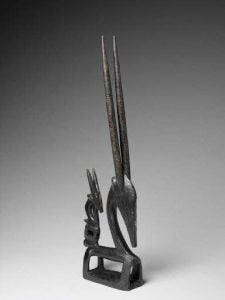
Older Bamana antelope masquerade crests vary in form and style a great deal, not only from i Bamana region to another, simply among artists. Formal typological studies place the vertically-oriented crests (Fig. 165) in the northern Bamana region around the town of Segou. This style has come to typify strange expectations of ciwara, which have become iconic examples of African art. The male person crest is larger, and indeed the performer who wears it is the star performer of the masquerade; the female appears to be nowadays to ensure his recognition as a complete male. Both male and female person (and infant male, carried on his mother's back every bit a man kid would be carried) a human-like nose, much similar those constitute on other Bamana sculptures; the female wears earrings, as many ci wara (only no wildlife) practise; some researchers draw the muzzle as bird-like rather than mammalian. The two genders are clearly differentiated, as the penis is prominent. Their upright horns differ slightly, and indeed they are said to represent two dissever antelope types (Fig. 166), the male a roan antelope, the female an oryx. Neither image is species-specific nor naturalistic. The heads dwarf the bodies, the legs are short and hoofless, the necks take on a geometric character. Although male roans do indeed have long ears, they have been exaggerated in the carved versions, and the gracefully arching neck is the artist's creation. They do have manes, but the triangular cut-outs that lighten the mass are pure fancy; while some researchers have stated the resulting zig-zags represent either the antelope's fits-and-starts path or the passage of the sun, these are no longer general Bamana interpretations, if they ever were. Whereas the actual roan has horns with a conspicuously backward bend, the carved version's horns are directly, angle backward at an bending at the top. although this is not inevitable (Fig. 167). While the wooden female crest does have the directly horns of the oryx, she does not otherwise follow its anatomy, and backs her young like a human female parent (Fig. 168). Prayers at the get-go of the old ritual performances ask Ci Wara the spirit for a bountiful harvest and plenty of new babies, attesting to the association of crop and human fertility.
Horizontalciwara crests (Fig. 169) originate from the Beledougou region of the western Bamana, who live n of Bamako and the Niger River in Mali. Their construction is very different from the monoxyl carvings of the vertical crests, for they represent a rarity in traditional African sculpture–a carpentered piece that does non come from a littoral expanse potentially impacted by European approaches. The joint between two pieces of wood always occurs at the neck, where metal staples (or occasionally a metal "collar") connect them. This is apparently a conceptual rather than a practical option, for area trees could easily conform this size of sculpture. These crests also have diminutive bodies
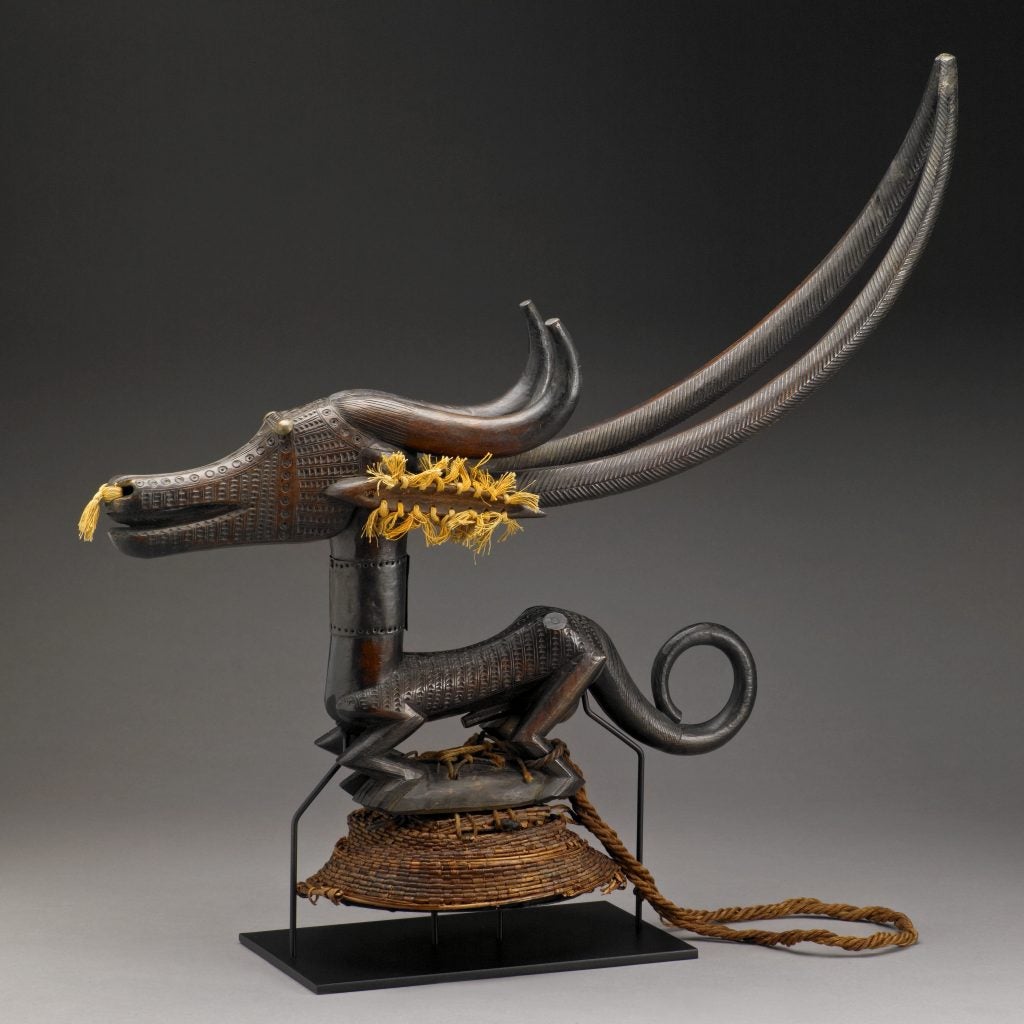
dominated by head and horns, and are also said to be modeled after roan antelopes. The impressive sweep of the horns, nonetheless, turns slightly upward, different those of an actual roan. The creature'south tongue is oft shown, and fine, varied geometric patterns ordinarily embrace both head and body. Eyes may be only partially carved, represented instead by inserts of metal studs or beads, and yarn tassels often add textural interest to ears and snout, as do metal, beaded, or shell earrings.
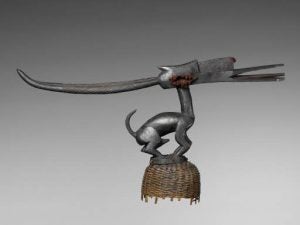

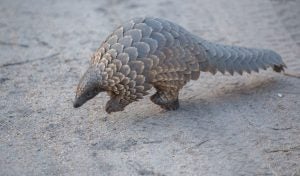
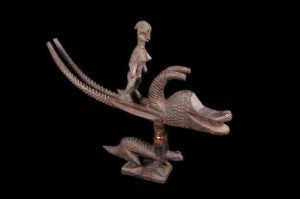
Many horizontal crests incorporate features of other animals, such every bit a chameleon's crimper tail. Although their tails actually curve downward, artists throughout the continent often portray them this mode. Chameleons are frequently associated with transformation considering of their colour shifts. Some of these composite animals have curved backs (Fig. 170) that refer to the aardvark (Fig. 171), a clawed animal whose digging abilities mirror those of a champion farmer; the long ears too bear a strong resemblance to those of aardvarks. The textured trunk may refer to a stylization of the pangolin (Fig. 172),

a scaled mammal that also uses its claws to dig for ants and termites. Other examples may include multiple sets of horns and/or add a human being figure (Fig. 173), or stack the head of i species over a second creature (Fig. 174).
The nearly curious aspect of these horizontal examples is their intentional joinery. Why two pieces of wood? A circuitous farming/mythological explanation is offered by the Romanian researcher Dominique Zahan: these crests represent an inverted world inspired past plants that flower underground, namely the legumes peanuts and Bambara groundnuts (Vigna subterranea).The border of above and below is marked by the joint, and animals represented above–such as the roan antelope or the caprine animal–are associated with the sun. Those below the bring together represent the underground realm, and nocturnal digging animals like aardvarks and pangolins. Inverted crimper tails and horns? They represent "that one hopes and expects to be able to harvest [groundnuts] easily" (Zahan and Roberts: 2000, p. 42). The bespeak of attachment? Non only does it symbolize the upper and lower aspects of groundnut and peanut growth, it is interpreted every bit maintaining the remainder between paternal and maternal kin in a Bamana region that places greater-
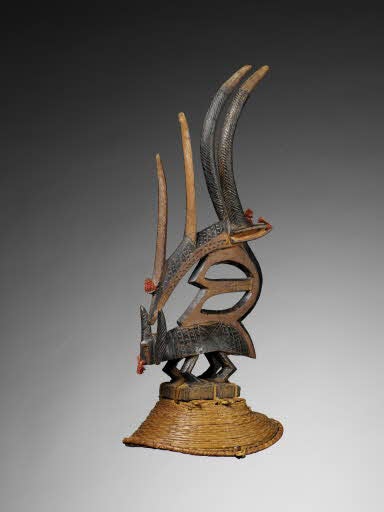
A third set of crests is far more abstract. Its origins may lay in a neighboring group that has influenced the Bamana, in a masquerade similar to ciwara but with separate origins, or to different stylistic choices. Based in the Wassalu region of southern Mali, which borders Guinea and Cote d'Ivoire, this multi-ethnic area composed of Fulani, Malinke, and Bamana mixes apparently impacted the neighboring southern and western Bamana. These crests are called sogoni-kun, and, although they sometimes performed in the fields, their choreography and cloth costumes differentiate them from ciwara. Confusing the thing, however, is the fact that some crests that appear to exist ciwara crests are also used in sogoni-kun and bear that name.

These crests oft include only a highly schematized indication of an antelope head, ofttimes surmounted by multiple sets of horns (Fig. 175). The head oft rests on the dorsum of an anteater, and a male person or female figure may indicate the "gender" of the paired dancer (Fig. 176).
Boosted crest variations are known, some visually aligned to i of the 3 major forms, others combining horns, figures and brute differences in increasingly abstract modes (Fig. 177).
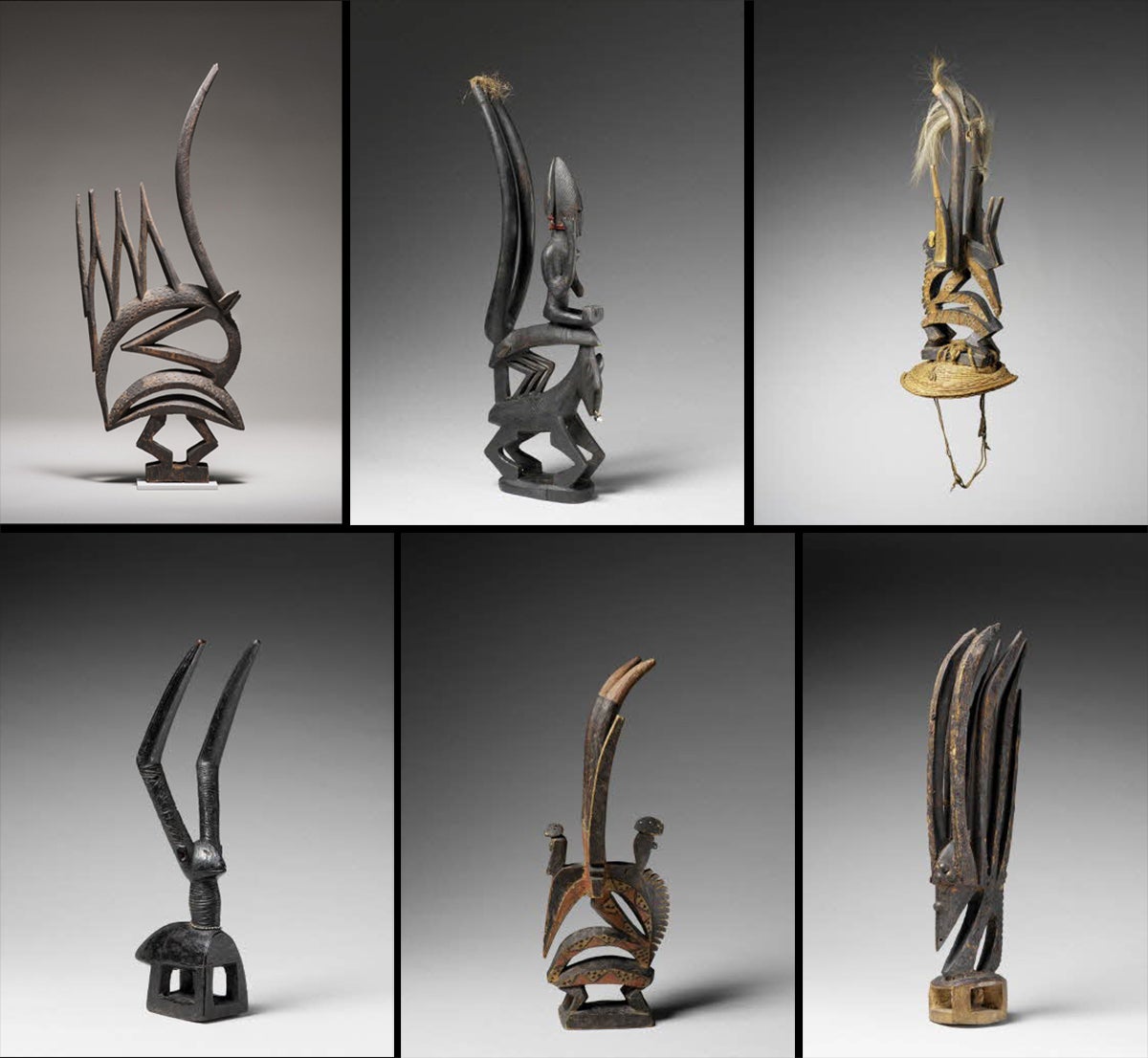
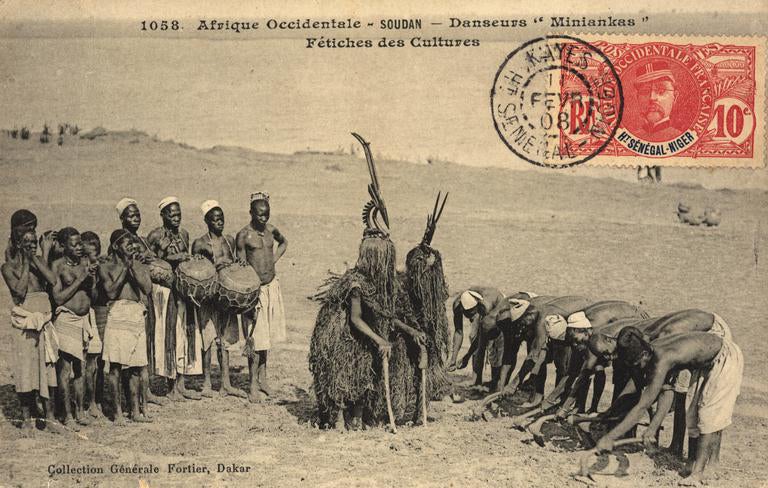
As is the case for some other Bamana masks and practices, antelope crests associated with farming are not necessarily limited to the Bamana. Their neighbors–Mande and non-Mande–apply similar crests, examples being found among the Marka, Wassalu, Minianka, the adjoining Senufo, and the Maninka of Fouladougou. Fifty-fifty a single epitome tin can confuse the issue (Fig. 178), as in the case of this postcard published every bit Minianka, nonetheless referred to in a 1912 book past a local French official as illustrating an agricultural festival of the Senufo of the Koutiala region. Later publications have used information technology to illustrate Bamana practices. Many forms of cultural expression cannot neatly exist bars by ethnic designations, but they practise provide a handy reference bespeak in the absenteeism of
creative person'southward names and specific provenance, which explains their persistence.

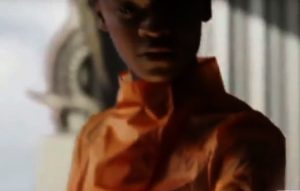
Since the early 20th century, the svelte forms of Bamana ciwara–particular those with vertical orientations–accept attracted the attention of Western collectors and artists. Although their utilize diminished or ceased, outside demand increased, and carvers–both Bamana and other–take matched the export market appetite with tourist fine art crests that accept never seen a field or a performer's head. For the Bamana, they take become a bluecoat, marking not simply their own territory through public sculpture at the gardens of Bamako's Urban center Hall or locally-produced clothing motifs, but nationally emblazoned every bit an airline logo (Fig. 179). For those outside the continent, the ciwarahave get one of the premier symbols of Africa, i of the few actual African sculptures to grace the Marvel Comics earth of Wakanda, a mythical nation (Fig. 180).
Further Reading
de Ganay, Solange. "On a Form of Cicatrization Among the Bambara."Man49 (May, 1949): 53-55.
Imperato, Pacal James. "Bambara and Malinke Ton Masquerades." African Arts thirteen (4, 1980): 47-55; 82-87.
Imperato, Pascal James. "The Dance of the Tyi Wara." African Arts 4 (ane, 1970): nine-13; 71-80.
Imperato, Pascal James. "Sogoni Koun." African Arts 14 (two, 1981): 38-47; 72; 88.
LaGamma, Alisa. Genesis: Ideas of Origin in African Sculpture. New York: Metropolitan Museum of Art, 2003.
Smithsonian National Museum of African Art, Washington, DC. "Togu Na and Cheko: Change and Continuity in the Art of Mali." 1989.
Vogel, Susan, ed. For Spirits and Kings: African Art from the Tishman Drove. New York: Metropolitan Museum of Art, 1981.
Wooten, Stephen R. "Antelope Headdresses and Champion Farmers: Negotiating Meaning and Identity through the Bamana Ciwara Complex."African Arts 33 (2, 2000): eighteen-33; 89-90.
Zahan, Dominique. Antilopes du soleil, Arts et Rites agraires d'Afrique Noire. Vienna: A. Schendl, 1980.
Zahan, Dominique and Allen F. Roberts. "The 2 Worlds of Ciwara." African Arts 33 (2, 2000): 34-45; 90-91.
Animals of the Present: Willie Bester's The Dogs of State of war and The Trojan Equus caballus
Willie Bester'due south Dogs of State of war (Fig. 181) is a menacing figure who has torn his atomic number 82 from whatsoever controlling hand. He lopes forward, snarling through his muzzle, his trunk a conglomeration of metal machine parts, a tin cup, batteries (or dynamite), with a battered only serviceable motorcar gun mounted on the dorsum. The mutual steel prevents distractions, urging an exam of the multiple textures that provide the uncared-for look of a truthful junkyard dog. He is all diagonals, their power and implied activity creating a Terminator-like futuristic effect that spawns feet.

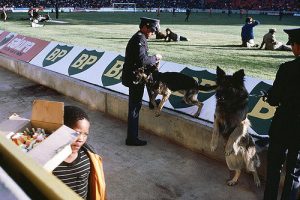
The artwork'due south name originates from Marc Anthony'due south line in Shakespeare's Julius Caesar: "Cry 'Havoc!', and let sideslip the dogs of war." "Havoc" was an actual military guild, one that called for consummate annihilation. While bodily armed services dogs were used past the Romans, the term also applies to mechanical devices that hold or fasten; "dogs of war" has as well come to hateful mercenaries. The title does non refer to a declared war; although S Africa had some interest in the Earth Wars, the Korean War, and the Namibian War for Independence, its last major armed services involvement took place internally with the Boer Wars that ended in the early 20th century.
If not a reference to an actual war, is the piece then a commentary on general havoc in S African club? While that layer of meaning may be present, this piece of work is really an prototype fatigued from an actual consequence, and the installation this work was a role of scrutinizes the event in multiple ways. In 1998, iv years after Nelson Mandela was elected president, some white South African police force in a canine training unit set their dogs on illegal immigrants from neighboring countries–and videoed themselves. An investigative television plan obtained the tape 2 years later, showing it to key politicians and dissemination it; one year later, those involved were sentenced. Bester's piece of work, produced the year of the convictions, was part of an installation that explored the event in multiple rooms. Its primal ensemble, calledWho let the dogs out? included a barricaded department through which viewers could get voyeurs of the violent original footage of intent German shepherds, discrete police, and terrified immigrants (see the video below; Warning, it is extremely graphic). The accompanying sculptural group included life-size bit metal policeman, a dog attacking the victim, and a 2nd policeman with a video camera replacing his head.
The image of the dog took on a dandy deal of prominence in the apartheid earth of S African artists. A potent symbol of constabulary brutality and the will to control, these German shepherds not only appeared in many journalistic photos (Fig. 1820, but likewise featured in the fine art of David Koloane–feral, without leashes or handlers–and Norman Catherine–where they were anthropomorphized with human being features and police caps. When apartheid ended and Mandela was elected to office a few years afterwards in 1994, South Africa attempted to accost its violent by history with a tribunal known equally the Truth and Reconciliation Committee (1996-1998) chaired by Bishop Desmond Tutu. Its investigation of incidents that took place from 1960-1994 was purgative, and many chose to believe that its confrontations–many broadcast–could be put away. Bester's Dogs of State of war and a number of subsequent works proceed to rip the scabs off a past that has not vanished. As reviewer Brenda Atkinson wrote in her positive view of the exhibition: "Detractors of Willie Bester's work are often bewildered by his relentless revisiting of the theme of racial injustice. It's every bit if, by refusing to conspire with the soothing discourses of rainbowism and renaissance, he is committing some kind of horrible social imitation pas, like revealing an operation scar over dinner party hors d'oeuvres."
Bester (b. 1956), who grew up under apartheid, neither forgets the ugly by nor its repercussions. He created three versions of another work entitled Trojan Horse. The starting time two versions were assembled from partially painted recycled materials, stiffly posed and mounted on wheels like pull-toys. These colorful examples were made by 1994, but the 3rd (Fig. 183), created some thirteen years afterward, has a grimmer, post-industrial expect like to that ofDogs of War, with an automated weapon again mounted on the animate being. Hither, too, the fauna is more than information technology seems. Its proper noun does not refer to the Homerian account of Odysseus's "gift" to the Trojans, but rather to a 1985 police performance in ane of Cape Boondocks's black neighborhoods. There had been anti-apartheid demonstrations at that place, and the Security and Railway police mounted an operation whereby a truck laden with boxes entered the surface area, only to accept men with automatic weapons announced behind the cartons and fire into the oversupply in an incident called the Trojan Horse Massacre. Two children and a young man died, with others wounded. Once again, videotape captured the incident. The perpetrators were investigated years later, in 1988, and thirteen were charged and turned over to the Attorney General of the region, who refused to prosecute. Other efforts at a civil case ended in acquittal. Bester, however, continues to dig upwards memories of these atrocities from the not-then-distant past. Here he transforms a horse with i leg raised from the typical Western portrayal of a victorious warlord into a savage reminder of heartless brutality. Other works past Bester can be viewed on the creative person'south website, and interviews with the artist can be viewed HERE and HERE.
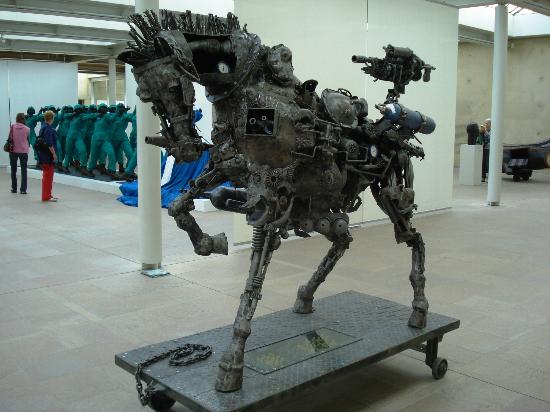
Source: https://pressbooks.ulib.csuohio.edu/bright-continent/chapter/chapter-3-1-animals/
Posted by: hambybuir1998.blogspot.com

0 Response to "Which Animal Is Most Commonly Found In Rock Art During The Bubalus Period?"
Post a Comment